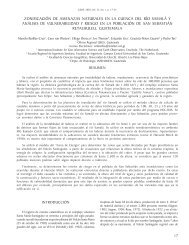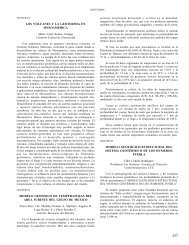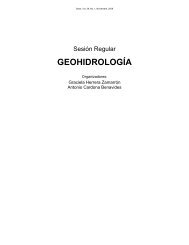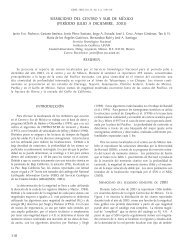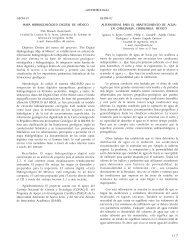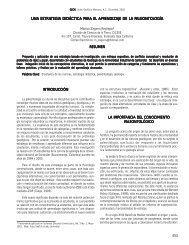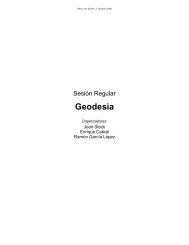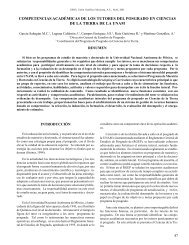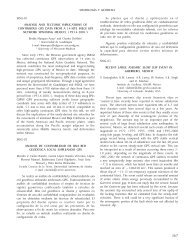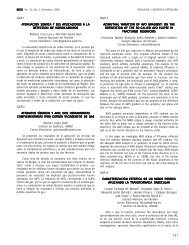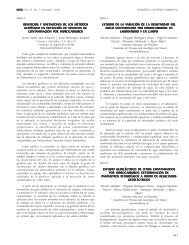Libro de Resúmenes - Unión Geofisica Mexicana AC
Libro de Resúmenes - Unión Geofisica Mexicana AC
Libro de Resúmenes - Unión Geofisica Mexicana AC
You also want an ePaper? Increase the reach of your titles
YUMPU automatically turns print PDFs into web optimized ePapers that Google loves.
EXTENSIÓN Y MAGMATISMO DURANTE LA RUPTURA CONTINENTAL EN EL<br />
GOLFO DE CALIFORNIA<br />
Geos, Vol. 30, No. 1, Noviembre, 2010<br />
SE14-1<br />
MAGMA-TECTONIC FEEDB<strong>AC</strong>K IN THE GULF OF CALIFORNIA RIFT<br />
Ferrari Luca 1 , Orozco Esquivel Teresa 1 , López Martínez Margarita 2 ,<br />
Lonsdale Peter 3 , Cerca Martínez Mariano 1 y Lino Escobedo Selene 2<br />
1 Centro <strong>de</strong> Geociencias, UNAM<br />
2 Departamento <strong>de</strong> Geología, División <strong>de</strong> Ciencias <strong>de</strong> la Tierra, CICESE<br />
3 Scripps Institution of Oceanography, University of California, San Diego<br />
luca@geociencias.unam.mx<br />
The relative role of tectonics and magmatism in controlling each other is a classic<br />
chicken or egg causality dilemma. Whereas lithospheric extension promote<br />
<strong>de</strong>compression melting and localize magma ascent, magmatic intrusions<br />
thermally weaken the crust, helping to focus extension. In the case of western<br />
Mexico, this magma-tectonic feedback was further complicated by the presence<br />
of a retreating subduction zone, that induced crustal stretching in the upper<br />
plate but also a progressive westward (trenchward) relocalization of the magma<br />
generation zone in the mantle. Our present integration of the continental and<br />
offshore geology, backed by several tens of new U-Pb and Ar-Ar ages, indicate<br />
that the Gulf of California is only the last episo<strong>de</strong> in a ~30-Ma-long history of a<br />
westward migrating magmatic and extensional pulses. During the last phases<br />
of subduction of the Farallon/Cocos plate, three episo<strong>de</strong>s of arc magmatism<br />
<strong>de</strong>veloped in a progressively western position: a ~38-28 Ma and ~24-18 Ma<br />
ignimbrite dominated episo<strong>de</strong>s in the southern Sierra Madre Occi<strong>de</strong>ntal silicic<br />
large igneous province (SMO) and an episo<strong>de</strong> of middle Miocene an<strong>de</strong>sitic<br />
magmatism represented by the middle and upper part of the Comondú group<br />
in Baja California. The second episo<strong>de</strong> is also well represented in the rifted<br />
continental blocks submerged in the southern Gulf of California (Orozco et al.,<br />
this session). Extension began in Late Oligocene along N-S to NNW-SSE faults<br />
in the eastern part of the SMO. However, the most intense faulting occurred<br />
in early Miocene (~20-12 Ma) when a major system of N-S to NNW-SSE<br />
extensional faults rifted the western si<strong>de</strong> of the SMO plateau concurrently with<br />
the <strong>de</strong>velopment of the Comondú an<strong>de</strong>sitic arc to the west (Ferrari et al., this<br />
session). This phase of orthogonal rifting, referred to as the Gulf Extensional<br />
Province, account for at least half of the crustal thinning in the Gulf. At ~12-10 Ma,<br />
shortly after the end of subduction, a bimodal suite ma<strong>de</strong> of basaltic dikes feeding<br />
flat lying lava flows and less abundant peralkaline ignimbrites was emplaced<br />
in western Sonora and along the Nayarit-Sinaloa coast and its corresponding<br />
offshore region, covering in unconformity the rifted continental blocks of the<br />
SMO. This bimodal pulse may be related to the <strong>de</strong>tachment of the lower part of<br />
the subducted slab, allowing asthenosphere to flow into the portion of the mantle<br />
previously fluxed by the subduction fluids. The final rupturing of the lithosphere<br />
was accomplished by the formation of transtensional basins <strong>de</strong>veloped further<br />
to the west since ~9 Ma, that eventually evolved into small oceanic basins in the<br />
Pliocene. Three Plio-Quaternary mafic volcanic fields in Sinaloa (Choix, Perico,<br />
and Cacaxtla) <strong>de</strong>veloped within 150 to 200 km to the east of the these oceanic<br />
basins but show a distinctive enriched signature very different from the typical<br />
MORB of the Alarcon basin.<br />
SE14-2<br />
INTRUSIVOS DEL MIOCENO TEMPRANO EN BLOQUES<br />
CONTINENTALES SUMERGIDOS Y EN AMBAS MÁRGENES<br />
DE LA PORCIÓN SUR DEL GOLFO DE CALIFORNIA<br />
Orozco Esquivel Teresa 1 , López Martínez Margarita 2 , Lonsdale Peter 3 , Ferrari<br />
Luca 1 , Cornejo Jiménez Candy 4 , Piñero Lajas Doris 2 y Duque Trujillo José 1<br />
1 Centro <strong>de</strong> Geociencias, UNAM<br />
2 Departamento <strong>de</strong> Geología, División <strong>de</strong> Ciencias <strong>de</strong> la Tierra, CICESE<br />
3 Scripps Institution of Oceanography, University of California, San Diego<br />
4 Instituto <strong>de</strong> Ciencias Básicas e Ingeniería, UAEH<br />
torozco@geociencias.unam.mx<br />
Durante dos cruceros realizados en 2008 y 2009 se colectó un gran número<br />
<strong>de</strong> muestras <strong>de</strong> la corteza continental sumergida en la porción sur <strong>de</strong>l Golfo <strong>de</strong><br />
California, empleando un vehículo sumergible <strong>de</strong> operación remota o dragados.<br />
El estudio <strong>de</strong> dichas muestras y la integración <strong>de</strong> la geología <strong>de</strong> las márgenes<br />
conjugadas en Baja California Sur, Sinaloa y Nayarit ha permitido una mejor<br />
comprensión <strong>de</strong> la historia magmática previa a la apertura <strong>de</strong>l Golfo.<br />
En trabajos previos se había consi<strong>de</strong>rado que las rocas intrusivas que afloran<br />
en la parte sur <strong>de</strong> Baja California, en el bloque <strong>de</strong> Los Cabos y las islas Santa<br />
Catalina, San José, San Diego, Santa Cruz y Espíritu Santo, constituyen el<br />
basamento y son correlacionables con el batolito Peninsular <strong>de</strong>l Cretácico tardío.<br />
A partir <strong>de</strong> nuevos datos geocronológicos, en este trabajo se documenta la<br />
presencia <strong>de</strong> intrusivos <strong>de</strong>l Mioceno temprano, y sus equivalentes volcánicos,<br />
en bloques continentales sumergidos y en ambas márgenes <strong>de</strong> la porción sur<br />
<strong>de</strong>l Golfo <strong>de</strong> California.<br />
Para rocas intrusivas <strong>de</strong> zonas sumergidas <strong>de</strong>l sur <strong>de</strong>l Golfo <strong>de</strong> California se<br />
obtuvo una edad U-Pb <strong>de</strong> 19.9 Ma y cuatro eda<strong>de</strong>s Ar-Ar entre 17.4 y 18.5 Ma<br />
en muestras recuperadas <strong>de</strong>l escarpe <strong>de</strong> la falla transformante Pesca<strong>de</strong>ro sur,<br />
<strong>de</strong> escarpes <strong>de</strong> fallas extensionales submarinas al SE <strong>de</strong> la cuenca Alarcón y<br />
<strong>de</strong>l banco al este <strong>de</strong> la Isla Cerralvo. También se obtuvieron eda<strong>de</strong>s Ar-Ar <strong>de</strong><br />
19.9 a 18.1 Ma en rocas graníticas que forman la parte sur <strong>de</strong> la Isla Santa<br />
Catalina y <strong>de</strong> 18.6 Ma para un granito <strong>de</strong> Bahía Concepción. Estos intrusivos<br />
tienen gran semejanza a los cuerpos que afloran en los ríos Santiago y San<br />
Pedro en Nayarit, los cuales fueron fechados en ~19 a 20 Ma.<br />
En el área también se ha i<strong>de</strong>ntificado la contraparte volcánica <strong>de</strong> esas rocas<br />
intrusivas. Tobas riolíticas dragadas al E y NE <strong>de</strong> la Isla Espíritu Santo arrojaron<br />
eda<strong>de</strong>s U-Pb <strong>de</strong> 21.3 a 20.5 Ma, mientras que an<strong>de</strong>sitas e ignimbritas <strong>de</strong> las<br />
Islas Danzante, Montserrat y Santa Catalina dieron eda<strong>de</strong>s Ar-Ar <strong>de</strong> 18.4 a 17.7<br />
Ma. Las litologías y eda<strong>de</strong>s son similares a las reportadas para la parte inferior<br />
<strong>de</strong>l Grupo Comondú alre<strong>de</strong>dor <strong>de</strong> Bahía <strong>de</strong> La Paz y en otras localida<strong>de</strong>s <strong>de</strong><br />
Baja California Sur (e.g., Hausback, 1984; Drake, 2005) y para el último pulso<br />
ignimbrítico <strong>de</strong> la parte sur <strong>de</strong> la Sierra Madre Occi<strong>de</strong>ntal (Ferrari et al., 2002 y<br />
datos nuestros no publicados).<br />
Las rocas ignimbríticas <strong>de</strong>l Mioceno temprano <strong>de</strong> Baja California Sur habían sido<br />
interpretadas como facies distales <strong>de</strong>l volcanismo <strong>de</strong> la Sierra Madre Occi<strong>de</strong>ntal;<br />
sin embargo, la distribución <strong>de</strong> los plutones silícicos en ambos lados <strong>de</strong>l Golfo<br />
y en los bloques sumergidos es evi<strong>de</strong>ncia <strong>de</strong> que el arco silícico <strong>de</strong>l Mioceno<br />
temprano se extendió a lo largo <strong>de</strong>l área don<strong>de</strong> ahora se localiza la parte sur <strong>de</strong>l<br />
Golfo <strong>de</strong> California y sus márgenes. Posteriormente, el arco fue <strong>de</strong>smembrado<br />
por el proceso <strong>de</strong> rifting, el cual pudo haber sido influido por el <strong>de</strong>bilitamiento<br />
térmico <strong>de</strong> la corteza causado por este evento magmático.<br />
SE14-3<br />
EL VOLCANISMO DE ARCO DEL MIOCENO<br />
INFERIOR EN EL NORTE DE BAJA CALIFORNIA<br />
López Martínez Margarita 1 , Martín Barajas Arturo 1 , Stock<br />
Joann 2 , Lino Escobedo Selene 1 y Piñero Lajas Doris 1<br />
1 Departamento <strong>de</strong> Geología, División <strong>de</strong> Ciencias <strong>de</strong> la Tierra, CICESE<br />
2 Caltech, USA<br />
marlopez@cicese.mx<br />
Las ultimas manifestaciones <strong>de</strong>l volcanismo <strong>de</strong> arco relacionado a la subducción<br />
<strong>de</strong> la placa Farallón y sus <strong>de</strong>scendientes las microplacas Guadalupe y<br />
Magdalena ocurrieron a lo largo <strong>de</strong>l margen occi<strong>de</strong>ntal <strong>de</strong>l Golfo <strong>de</strong> California.<br />
Las secuencias calco-alcalinas <strong>de</strong>l arco en Baja California están compuestas<br />
<strong>de</strong> dacitas an<strong>de</strong>sitas y an<strong>de</strong>sitas basálticas principalmente asociadas a<br />
estratovolcanes. La compilación <strong>de</strong> eda<strong>de</strong>s disponibles muestra que el<br />
volcanismo <strong>de</strong> arco en la parte norte <strong>de</strong> la península ocurre en campos aislados<br />
entre el Mioceno medio e inferior (~ 14 a 20 Ma). En contraste en Baja<br />
California Sur el volcanismo es mas abundante, con una distribución continua,<br />
predominantemente <strong>de</strong> composición ácida (riolita-dacita), y el rango <strong>de</strong> edad es<br />
mayor (~ 12 a 22 Ma). Una diferencia importante es a<strong>de</strong>más la presencia <strong>de</strong><br />
intrusivos Miocénicos que sugieren la exhumación <strong>de</strong> un espesor consi<strong>de</strong>rable<br />
<strong>de</strong> la corteza previamente a la subsi<strong>de</strong>ncia generalizada.<br />
Las islas <strong>de</strong>l Golfo <strong>de</strong> California también contienen un registro volcánico que<br />
documenta el cambio <strong>de</strong> régimen <strong>de</strong> subducción al régimen transtensivo <strong>de</strong>l rift.<br />
El reconocimiento geológico <strong>de</strong> la mitad norte <strong>de</strong> Isla Ángel <strong>de</strong> la Guarda indica<br />
que una potente secuencia volcánica (~1000 m <strong>de</strong> espesor) sobreyace a un<br />
basamento granítico-metamórfico y arcosas prevolcánicas <strong>de</strong>rivadas <strong>de</strong> éste.<br />
La secuencia incluye un complejo volcánico basal <strong>de</strong> 500-600 m <strong>de</strong> espesor <strong>de</strong><br />
domos y brechas dacítico-an<strong>de</strong>siticas y flujos <strong>de</strong> lava basáltica subordinados.<br />
Este complejo compren<strong>de</strong> <strong>de</strong>pósitos epiclásticos fuertemente basculados por la<br />
actividad <strong>de</strong> las fallas en el litoral noroeste <strong>de</strong> la isla. Hacia la cima la secuencia<br />
an<strong>de</strong>sítica esta truncada y cubierta en discordancia por domos rioliticos y<br />
tobas intercaladas en una secuencia aluvial <strong>de</strong> conglomerado-arenisca. Las<br />
relaciones <strong>de</strong> contacto indican que las tobas <strong>de</strong> lapilli pumicítico son cogenéticas<br />
con los domos riolíticos.. Dos eda<strong>de</strong>s 40Ar/39Ar <strong>de</strong> 15.6 ± 0.2 y 13.3 ±<br />
0.2 Ma, obtenidas en hornblenda, indican que la principal actividad volcánica<br />
an<strong>de</strong>sítica correspon<strong>de</strong> a estratovolcanes <strong>de</strong>l arco miocénico. Una edad <strong>de</strong><br />
11.8 ± 0.2 Ma en sanidino <strong>de</strong> una toba soldada intercalada en la cima <strong>de</strong> la<br />
secuencia sedimentaria sugiere que los domos rioliticos, tobas, flujos máficos y<br />
conos <strong>de</strong> escoria correspon<strong>de</strong>n a una actividad volcánica distinta a la actividad<br />
an<strong>de</strong>sitica-dacitica <strong>de</strong> arco. Resultados comparables han sido obtenidos para<br />
los campos volcánicos <strong>de</strong> San Luis Gonzaga, Bahía <strong>de</strong> los Ángeles, Puertecitos,<br />
Sierra Pinta y Sierra Las Tinajas en el norte <strong>de</strong> Baja California<br />
Las diferencias en volumen y espesor <strong>de</strong> la secuencia <strong>de</strong> arco entre el norte<br />
y el sur <strong>de</strong> la península pue<strong>de</strong>n atribuirse al cese progresivo <strong>de</strong> la subducción<br />
hacia el sur durante el Mioceno inferior. Dado el estado térmico <strong>de</strong> la litósfera<br />
bajo el arco Comondú el inicio <strong>de</strong>l rift se ubicó a lo largo <strong>de</strong>l eje <strong>de</strong> actividad<br />
volcánica <strong>de</strong>l arco.<br />
192


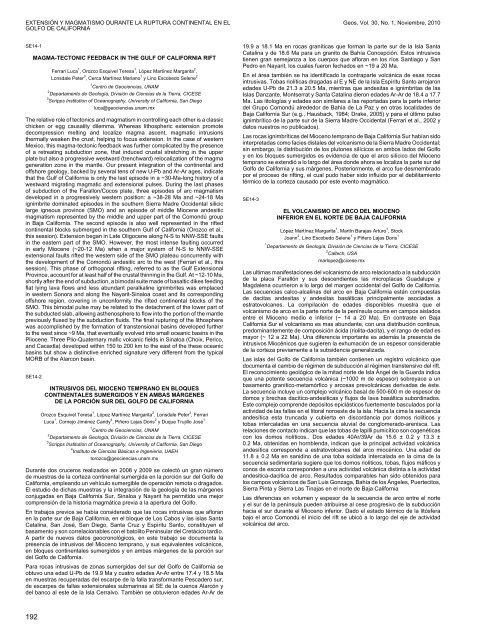
![Libro de resúmenes [revisión final, 172 páginas] - UGM](https://img.yumpu.com/51565067/1/190x245/libro-de-resamenes-revisian-final-172-paginas-ugm.jpg?quality=85)
